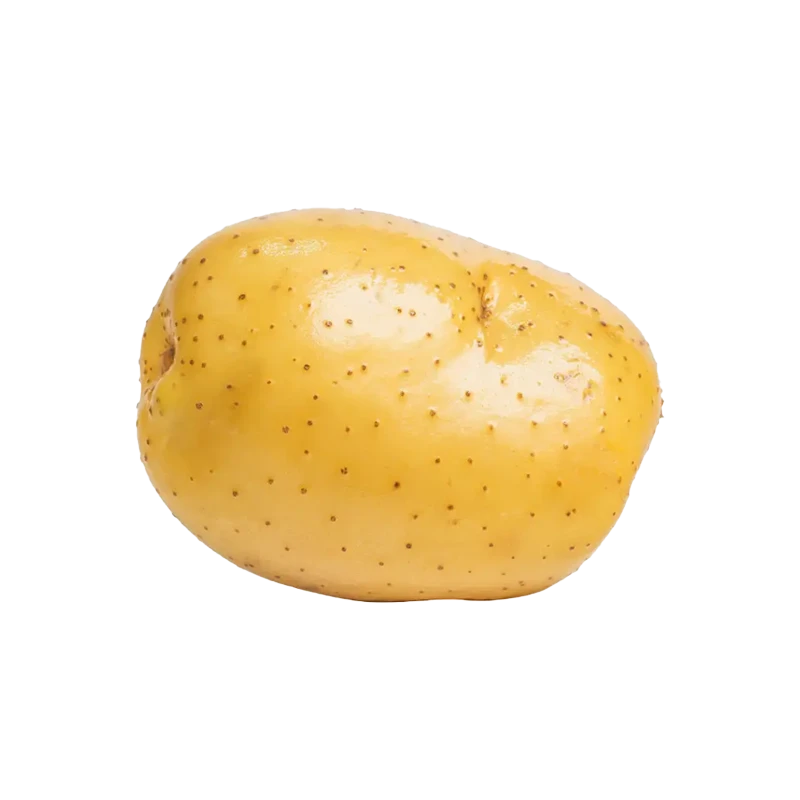Potatoes — Nutrients, Health Benefits, And Shopping Tips

Written by Listonic Team
Last update on September 6, 2024
Potatoes nutrients
Nutrition facts
Amount per 100 g
Calories
🔥 77 kcal
| Nutrition per: 100 g | Value | % Daily Value* |
|---|---|---|
| Carbs | 18 g | 6.55% |
| Fiber | 2 g | 7.14% |
| Sugars | 1 g | 2% |
| Glycemic Index | 80 | - |
| Protein | 2 g | 4% |
| Sodium | 6 mg | 0.26% |
| Total Fat | 0 g | - |
*The % of Daily Value (DV) tells you how much a nutrient in a serving of food contributes to a daily diet. 2,000 calories a day is used for general nutrition advice.
1 g
🍏 Low Sugar Content
Potatoes facts & tips
Health benefits
- Rich in vitamins and minerals such as Vitamin C, potassium, and Vitamin B6, which support immune function, heart health, and overall well-being.
- High in fiber (especially with the skin on), promoting digestive health, regular bowel movements, and a healthy gut microbiome.
- Contains antioxidants such as flavonoids, carotenoids, and phenolic acids, which help protect the body from free radicals and reduce inflammation.
- Provides sustained energy from complex carbohydrates, making them a good source of fuel for the body and brain.
- Supports heart health due to their potassium content, which helps regulate blood pressure.
Health risks
- High carbohydrate content which can cause rapid spikes in blood sugar levels, particularly concerning for diabetics or those on low-carb diets.
- Potential for high calorie content particularly when potatoes are prepared with added fats like butter, oil, or cheese, which can contribute to weight gain if consumed frequently.
- Risk of digestive discomfort such as bloating or gas when consumed in large quantities, especially if potatoes are not properly cooked.
- Potential for contamination with pesticides or harmful bacteria if not properly washed or sourced from a reputable supplier.
How to choose potatoes
When choosing potatoes, opt for those that are firm with smooth, unblemished skins. The eyes should be shallow and the skin should not show any signs of greening. The weight of the potatoes should feel heavy for their size.
Avoid potatoes that have soft spots, sprouts, or a green tint under the skin, as these signs can indicate age or improper storage. Potatoes with cuts or bruises should also be avoided, as they are more susceptible to spoilage.

How to store potatoes
Potatoes should be stored in a cool, dark place, such as a pantry or cellar. Keeping them in a paper or mesh bag allows for proper ventilation. Properly stored, potatoes can last for several weeks.
Exposure to light can cause potatoes to turn green and become toxic. Avoid storing them in plastic bags without ventilation, as this can trap moisture and lead to sprouting and rot. Always check potatoes for soft spots or sprouts before use.
✅ Extra Tip
How long do they last?
Potatoes can last for 1-2 months when stored in a cool, dark place with good ventilation. Cooked potatoes should be consumed within 3-5 days if kept in the refrigerator.
What to do with leftovers?
Leftover potatoes can be used in a variety of versatile dishes. Dice them and add to a stir-fry with vegetables and your choice of protein, or mash them with butter and cream for a quick side dish. Potatoes are also great when roasted with olive oil, garlic, and herbs for a crispy, golden treat.
Use leftover potatoes to make a batch of potato pancakes or hash browns by grating them and frying until crispy, or mix them into a potato salad with mayonnaise, mustard, and fresh herbs. If you have a lot of potatoes, consider making a shepherd’s pie by layering mashed potatoes over a mixture of ground meat and vegetables, then baking until golden. Potatoes can also be sliced and used in a gratin with cheese and cream, or stuffed and baked with your favorite toppings. For a quick snack, slice and fry potatoes for homemade potato chips, or bake them and serve with sour cream and chives.
👨⚕️️ Medical disclaimer
Discover products from other categories
Listonic Team
Fact-checked
Our editorial team checked this article to make sure it was accurate at the time of publishing it.
Get the top-rated shopping list app on your phone!







